
PawSit
find immediate caretaking solution for your pet
Project Summary
Our team of five tackled the design challenge of creating a mobile app that seamlessly connects pet owners with pet care services in a timely and flexible manner. Throughout the semester, we progressed through key phases—ideation, user research, and product design—to develop a polished solution as the final project for our Master's in Information program's Fundamentals of UX course.
Team Members:
Yicheng Li, Yifan Jiang, Yancy Zhang, Yolanda Wei, Yunding Ye
My role:
Conducted user research with 2 participants
Created a quick design system for the use of group
Designed the Home Page and Service Provider Profile Page
Presented the final presentation
Overview
What Have We Done?
Define The problem
Find the Solution
Research & Interview
Low Fidelity Design
High Fidelity Design
Imagine coming home after a long, exhausting day, only to realize your dog still needs their walk—no prior booking, no plan. What if help was just a tap away?
Pawsit is a mobile app solution to make pet care effortless and stress-free. With just a tap, Pawsit connects you with trusted dog walkers and pet care providers in your area, available on demand—no need for advanced scheduling.
Problem Statement
How might we connect pet owners with trusted, reliable caretaking services, ensuring pets stay happy and healthy while their owners have peace of mind?
Research Phase
Research Question
-Popular services
-Experiences on Services
-Main Services
Key Areas of Focus
-What are the user’ needs
-How do users access the services?
-What do the users think of services?
Inclusion Criteria
Toronto Resident
Has pets
Is using pet services
To better understand the daily challenges faced by pet owners, we conducted semi-structured interviews to gain insights directly from them. By diving into their real-life struggles and pain points, we were able to identify the most pressing issues and refine our approach to prioritize and develop features that truly address their needs.
User Needs
Pet Behaviors
Factors Influencing choice of services
Research Findings / Pain Points
After conducting interviews, we found the following major paint points of pet owners
Difficulty finding reliable pet care
Inflexible Scheduling and booking
Anxiety about pet well-being
Limited options for personalized care
High costs for quality care
User Persona
Based on our research findings, we developed a detailed user persona named Serena to represent our target audience and guide our product design decisions.
Now, let’s explore our design phase and see how Serena’s pet care journey could be transformed!
Low Fidelity Design & User Testing
Based on our research findings and Serena’s key needs, we developed low-fidelity wireframes to gain an initial understanding of how the app's features would function and address her challenges.
Iterations: To ensure our design was intuitive, we conducted user testing sessions with our classmates and gathered feedback for improvements. For example, we discovered that users struggled with the navigation between service categories, so we streamlined the menu for easier access. Additionally, we refined the booking process after receiving feedback that it felt too lengthy, simplifying it to a more user-friendly flow. These iterations allowed us to make targeted improvements, ensuring the app better meets Serena’s needs and enhances overall usability.
4.
Solution: High Fidelity Design
Now lets follow Serena’s user journey with Pawsit!
2.
Serena can quickly find a dog walker nearby for an immediate walk with just a few taps. Alternatively, she can schedule standard bookings, including recurring walks, to ensure her furry friend gets consistent care.
5.
3.
After a long day at work, Serena plans to enjoy a night out with her girlfriends, but realizes she hasn’t had the chance to walk her dog yet. With a quick glance at her phone, she opens Pawsit and discovers she can easily connect with a dog walker—just like ordering an Uber!
To give Serena peace of mind, Pawsit provides access to detailed profiles of pet sitters, including their qualifications, past reviews, and photos, ensuring she finds the perfect match for her pet.
Now, Serena can fully enjoy her night out, knowing her puppy is in safe hands and receiving the attention and care it deserves, without feeling lonely or left behind.
Pawsit's intuitive account page allows Serena to manage her bookings effortlessly. She can review her complete booking history to track past services, make adjustments to upcoming appointments, and customize her preferences to fit her pet’s needs. Additionally, she can easily update essential information about her pets, such as their age, breed, medical details, and care instructions, ensuring every service is perfectly tailored—all with just a few clicks.
If Serena is planning for her future pet care needs, Pawsit makes it easy to set up recurring bookings. She can explore a wide range of available options, taking her time to review and compare based on key preferences like price range, service types, and even specific qualifications of pet sitters. This way, Serena can find the perfect fit for her schedule and her pet’s unique needs, ensuring consistent, reliable care every time.
Conclusion& Learnings
Building Pawsit has been a rewarding journey of creating meaningful solutions for pet owners and their companions. This project taught me the importance of user-centered design, blending functionality with intuitive experiences to meet real-world needs.
I honed my skills in project management, collaboration, and adaptability, ensuring the product evolved with feedback. Most importantly, I learned the value of empathy in technology—crafting tools that genuinely improve lives. This experience has strengthened my commitment to designing impactful and user-focused products for the future.






















